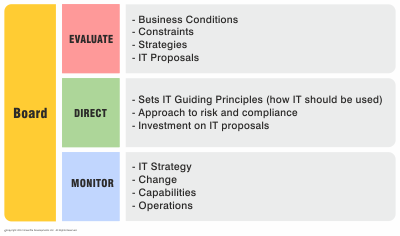 IT Governance
IT Governance
 IT Governance is most simply described as a framework for the organisational structures and associated processes and standards that ensure IT supports the achievement of strategic objectives of the company.
IT Governance is most simply described as a framework for the organisational structures and associated processes and standards that ensure IT supports the achievement of strategic objectives of the company.
As such, IT Governance is different to IT Management – IT Management is about the day-to-day decision making and implementation activities within an IT function. Governance sets out who will make key IT decisions and how they will be held accountable.
IT Governance is taken to include a wide variety of topics, including strategy, technology, risk management, intellectual property, process design, project management and IT investment. It can be simply depicted in the categories on the right.
The international standard for Corporate Governance of Information and Communication Technology (ISO/IEC 38500 -2008) simplifies this even further, identifying three main IT governance areas for company directors:
- Evaluate
- Direct
- Monitor

In reality, there are often several levels of governance and accountability (generally in the form of IT Strategy Committees, Programme Boards and Project Boards) between the Directors and the implementers of IT – and the roles, responsibilities and accountabilities of each of these needs to be defined and aligned.
Any effective IT governance framework is likely to include (as a minimum) a number of methodologies focused on each of the core areas – for example, COBIT, ITIL, Zachman, TOGAF, PRINCE 2, MSP are just a few of the more well known ones. It is a challenge to bring these together into an over arching framework, but the Calder-Moir Framework provides a logical approach to organising and deploying each of the tools available in the different methodologies.
More detailed and useful information on IT Governance can be found at www.itgovernance.co.uk (this opens in a new window).
IT Governance is an increasingly important aspect of IT – information and information systems are fundamental to business operations – and increasingly to achieving competitive advantage. Investment in IT continues to grow and organisations need to monitor and control this investment to ensure the benefits are realised.
Sound governance has been shown to deliver results: in organisations with a relatively high level of maturity in governance, profits are up to 20% higher than those that don’t – because responsibility of being taken to ensure that the overall IS Strategy is aligned to the Business Strategy, that benefits are being realised and sound investment decisions have been made. Conversely, organisations with poor or no IT Governance have been seen to fail in delivering projects more than 50% of the time.
Greenfile Developments provides a range of services within the IT Governance arena. We can provide assistance in helping assess your organisation’s overall IT Governance maturity, working with you to build a roadmap for improvement – and as practitioners, are aware of the difficulties encountered in introducing new ways of working.
We can work with you to build sound investment proposals to support your overall business strategies and set up relevant and appropriate governance frameworks – providing an assurance that initiatives underway will be successfully delivered through appropriate performance and management controls.
top
